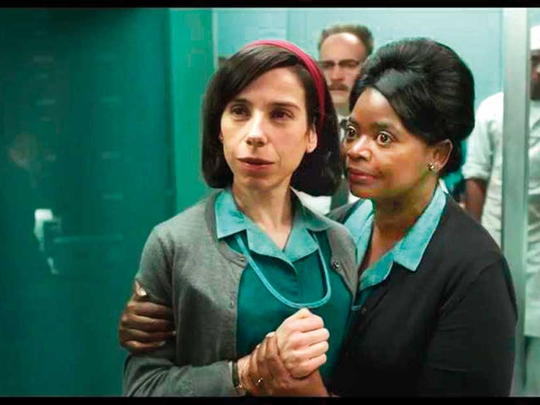
It’s an uphill task to examine Guillermo del Toro’s The Shape of Water through the lens of its Oscar win from last Sunday. What better recommendation than two major Academy Awards, one for the critically acclaimed Mexican director and the other for the film itself?
A visually stunning adventure that’s part monster film, part romantic fable, and part Cold War thriller, The Shape of Water is a playground for some of Del Toro’s favourite themes — war-time conflict, the underdog story, magic realism and fables.
The opening sequence, wistfully scored by Alexander Desplat, is a gorgeous underwater scene bathed in a bluish-green palette (a teal undertone that remains through the length of the movie) that instantly informs the viewer that we’re now strictly in the world of fantasy. Del Toro’s deft and ingenious implementation of this visual currency is what keeps us glued through until the end, and helps ease the suspension of disbelief. And you needn’t have seen his previous films to get into it either.
Set in the early 1960s in Baltimore, a time when racism and other kinds of discrimination were a large and expected presence in everyday life, The Shape of Water is largely concerned with its central character Elisa (Sally Hawkins) — a young, mute woman. She lives alone above a cinema and works as a cleaner at a mysterious government laboratory. She also has two very close friends — her neighbour Giles (the ever dependable Richard Jenkins), who is a lonely, middle-aged artist struggling to keep up with the times; and her co-worker Zelda (an under-used Octavia Spencer), loud-mouthed but wise, and always ready to cover for Elisa.
One day, the facility receives a consignment that houses a magical, marine creature (the magnificent chameleon Doug Jones), brought in by the film’s main antagonist Colonel Richard Strickland (Michael Shannon), who finds a maniacal pleasure in torturing our fish man. Helping Strickland study the creature, is Dr Robert Hoffstetler (Michael Stuhlbarg), whom you might remember as the benevolent father from Call Me By Your Name, and who gives a performance to remember in a very short time yet again.
Things heat up when the mute caretaker and the water creature connect (over a hard-boiled egg of all things), and it’s a predictable, but beautiful, ride from there. There’s a heartwrenching simplicity to the moments between Hawkins and Jones’ fish man, and the skill with which both the actors manage to communicate without words is a joy to watch. The film’s second underwater scene needs to be seen to be believed, memes notwithstanding.
Del Toro empowers his leading lady with a sexual and personal agency seldom seen on a big-budget film. Hawkins’ Elisa may be mute but she will not take things lying down, and is not afraid to seek out what she desires, even if it means risking her job, heart or even life. And Hawkins delivers a performance of a lifetime with this role: her large expressive eyes manage to say more than the rest of the speaking actors combined.
However, as deep and nuanced Hawkins’ character may be, the rest of the characters are as thinly drawn, and this is the biggest complaint about this film. There’s something eerily off about The Shape of Water, because while it talks about championing the have-nots against the haves, the marginalised against the privileged, and the silenced against those with power, it manages to reduce its ancillary characters to mere types. Jenkins’ Giles is the shy homosexual best friend, destined for loneliness. Spencers’ Zelda is the African American woman with sass, dispensing wisdom like hot cakes.
Even Shannon, who is definitely a memorable villain, had little nuance to play with. But the reasons these characters work, despite the weakness in the script, are the actors who play them. Everyone brings their A game to the table, and it’s hard not to be swept away by all the magnificence.
Del Toro works best when he brings an edginess to his fantastical worlds (Hellboy, Blade II) and innocence to the macabre (Pan’s Labyrinth, Devil’s Backbone). The Shape of Water falls somewhere between the cracks of his strengths and thus, wavers.
But for all its weaknesses, the film looks like it’s ready to stand the test of time. In a world that’s increasingly divisive, we need more voices that will bring us together, and Del Toro’s is one among those.









